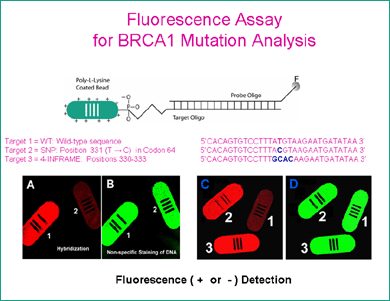Maxwell Sensors Inc. has combined two
advanced technologies,
lithographic digital barcodes
and molecular chemistry, to
create its new, patented Digital
Magnetic Beads (DMB) technology,
a breakthrough designed to
significantly improve the isolation and
identification capacity of molecular
diagnostics. MSIís digital
microbead (100-300
Ķm)
has the highest multiplexed
barcodes (5 - 1,024) in the
world.
Maxwell Sensors Inc. has span-off Digital Magnetic Beads
technology to
Applied BioCode, Inc., which
was formed to commercialize the
multiplex
Digital Magnetic Beads for
molecular diagnostics and life
science applications.
Optically bar-coded beads are fabricated
at low cost by photolithography.
The beads can be functionalized
with nucleic acids, proteins or
other probe molecules, allowing
large multiplexed assays to be
carried out in homogeneous or
heterogeneous media.
The digital readout system includes a
microfluidic transducer, a
bar-code reader and fluorescence
detection. The digital beads can
also be decoded by image
processing.
(a) A mixture of digital beads
carboxylated with probes are
introduced into a small sample
volume for all-in-one assay; (b)
A microscopic sectional image of
10-digit bar-code beads on a
substrate. For example, using
10-digit representing 0010110101
on a single microbead allows for
1,024 ( = 210)
unique identification codes; (c)
Digital magnetic beads inside a
microplate; (d) Microplate
imaging; (e) Microfluidic bead
decoding and fluorescence
detection.
MSIís improved approach offers substantial
advantages over the current
state-of-the-art in magnetic
bead technology. Because of its
simplicity, scalability, and
extremely low cost (one bead for
one test), this technology may
fundamentally change the format
of in-vitro diagnostics.
-
Its
flexibility enables new
probes to be added quickly
to multiplexed (5 -1,024)
assays in a single tube.
-
The size
of the microbead (2,000
beads= 0.8 Ķl) is so small
that assays can be conducted
with as little as one
droplet of sample.
-
The beadsí paramagnetic properties make the technology well
suited for washing,
purification, and automation
protocols.
-
The beads support both high speed and high throughput (< 30
seconds for thousands of
beads).
-
The beads can be mass produced at low cost.
-
Reactions are all-in-one and can be carried out in small
volumes saving labor,
reagents and consumables.
-
The technology is adaptable to automation using a 96-well
or 384-well plate format.
∑
Immuno-diagnostics
∑
Allergy testing
∑
HLA typing
∑
Autoimmune Diseases
∑
Infectious Diseases
∑
Genetic Diseases
∑
Cystic fibrosis
∑
Cytochrome P450
Life Sciences & Pharmaceutical Research:
∑
Cancer markers
∑
Cytokines, chemokines, and growth factors
∑
Endocrine
∑
Neurobiology
∑
Metabolic markers
∑
Gene expression profiling, Genotyping
The graphic that follows illustrates a fluorescence assay for BRCA1
Mutation analysis:

Contact Maxwell Sensors to learn how magnetic digital bead technology can benefit
your organization.